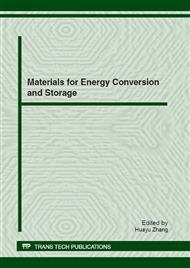[1]
P.V. Kamat, Quantum dot solar cells. Semiconductor nanocrystals as light harvesters, J. Phys. Chem. C 112(48) (2008) 18737–18753.
DOI: 10.1021/jp806791s
Google Scholar
[2]
G. Hodes, Comparison of dye- and semiconductor-sensitized porous nanocrystalline liguid junction solar cells, J. Phys. Chem. C 112 (2008) 17778-17787.
DOI: 10.1021/jp803310s
Google Scholar
[3]
F. Hetsch, X. Xu, H. Wang, S.V. Kershaw, A.L. Rogach, Semiconductor nanocrystal quantum dots as solar cell components and photosensitizers: material, charge transfer, and separation aspects of some device topologies, J. Phys. Chem. Lett. 2(15) (2011) 1879-1887.
DOI: 10.1021/jz200802j
Google Scholar
[4]
M. Graetzel, The advent of mesoscopic injection solar cells, Prog. Photovolt: Res. Appl. 14 (2006) 429.
DOI: 10.1002/pip.712
Google Scholar
[5]
T. Soga, Nanostructured materials for solar energy conversion, Elsevier, Amsterdam, 2006.
Google Scholar
[6]
W.W. Yu, L.H. Qu, W.Z. Guo, X.G. Peng, Experimental determination of the extinction coefficient of CdTe, CdSe, and CdS Nanocrystals, Chem. Mater. 15(14) (2003) 2854–2860.
DOI: 10.1021/cm034081k
Google Scholar
[7]
A. Kongkanand, K. Tvrgy, K. Takechi, et al., Quantum dot solar cells. Tuning Photoreponse through size and shape control of CdSe-TiO2 architecture, J. Am. Chem. Soc. 130(12) (2008) 4007.
DOI: 10.1021/ja0782706
Google Scholar
[8]
W.T. Sun, Y. Yu, H.Y. Pan, X.F. Gao, Q. Chen, L.M. Peng, CdS quantum dots sensitized TiO2 nanotube-array photoelectrodes, J. Am. Chem. Soc. 130(4) 1124-1125.
DOI: 10.1021/ja0777741
Google Scholar
[9]
S.J. Moon, Y. Itzhaik, J.H. Yum, S.M. Zakeeruddin, G. Hodes, M. Graetzel, Sb2S3-based mesoscopic solar sell using an organic hole conductor, J. Phys. Chem. Lett. 1(10) (2010) 1524-1527.
DOI: 10.1021/jz100308q
Google Scholar
[10]
R. Vogel, P. Hoyer, H. Weller, Quantum-sized PbS, CdS, Ag2S, Sb2S3, and Bi2S3 particles as sensitizers for various nanoporous wide-bandgap semiconductors, J. Phys. Chem. 98 (1994) 3183–3188.
DOI: 10.1021/j100063a022
Google Scholar
[11]
P.R. Yu, K. Zhu, A.G. Norman, S. Ferrere, A.J. Frank, A.J. Nozik, Nanocrystalline TiO2 solar cells sensitized with InAs quantum dots, J. Phys. Chem. B 110(50) (2006) 25451-25454.
DOI: 10.1021/jp064817b
Google Scholar
[12]
Q.J. Jun, J.Z. Guo, S. Yong, W.W. Bing, C.Z. Qie, Preparation of CuInS2 thin films by ion layer gas reaction, J. Chin. Ceram. Soc. 33(1) (2005) 26-31.
Google Scholar
[13]
B. Tell, J.L. Shay, H.M. Kasper, Electrical properties, optical properties, and band structure of CuGaS2 and CuInS2, Phys. Rev. B 4(8) (1971) 2463-2471.
Google Scholar
[14]
C.H. Chang, Y.L. Lee, Chemical bath deposition of CdS quantum dots onto mesoscopic TiO2 films for application in quantum-dot-sensitized solar cells, Appl. Phys. Lett. 91(2) (2007) 053503.
DOI: 10.1063/1.2768311
Google Scholar
[15]
M.P. Valkonen, T. Kanniainen, S. Lindroos, M. Leskel, E. Rauhala, Growth of ZnS, CdS and multilayer ZnS/CdS thin films by SILAR technique, Appl. Surf. Sci. 115(4) (1997) 386-392.
DOI: 10.1016/s0169-4332(97)00008-1
Google Scholar
[16]
Q.L. Zhang, T. Xu, D. Butterfield, et al., Controlled placement of CdSe nanoparticles in diblock copolymer templates by electrophoretic deposition, Nano. Lett. 5(2) (2005) 357-361.
DOI: 10.1021/nl048103t
Google Scholar
[17]
J.M. Feng, J.J. Han, X.J. Zhao, Synthesis of CuInS2 quantum dots on TiO2 porous films by solvothermal method for absorption layer of solar cells, Prog. Org. Coat. 64(2) (2009) 268-273.
DOI: 10.1016/j.porgcoat.2008.08.022
Google Scholar
[18]
M. Nanu, J. Schoonman, A. Goossens, Solar-energy conversion in TiO2/CuInS2 nanocomposites, Adv. Funct. Mater. 15(1) (2005) 95-100.
DOI: 10.1002/adfm.200400150
Google Scholar
[19]
J.J.Wu, W.T. Jiang, W.P. Liao, CuInS2 nanotube array on indium tin oxide:synthesis and photoelectrochemical properties, Chem. Comm. 46(32) (2010) 5885-5887.
DOI: 10.1039/c0cc01314e
Google Scholar
[20]
M. Nanu, J. Schoonman, A. Goossens, Nanocomposite three-dimensional solar cells obtained by chemical spray deposition, Nano. Lett. 5(9) (2005) 1716-1719.
DOI: 10.1021/nl0509632
Google Scholar
[21]
J. Alvarez-Garcia, A. Perez-Rodriguez, B. Barcones, et al., Polymorphism in CuInS2 epilayers: origin of additional raman modes, Appl. Phys. Lett. 80 (2002) 562-564.
DOI: 10.1063/1.1435800
Google Scholar



